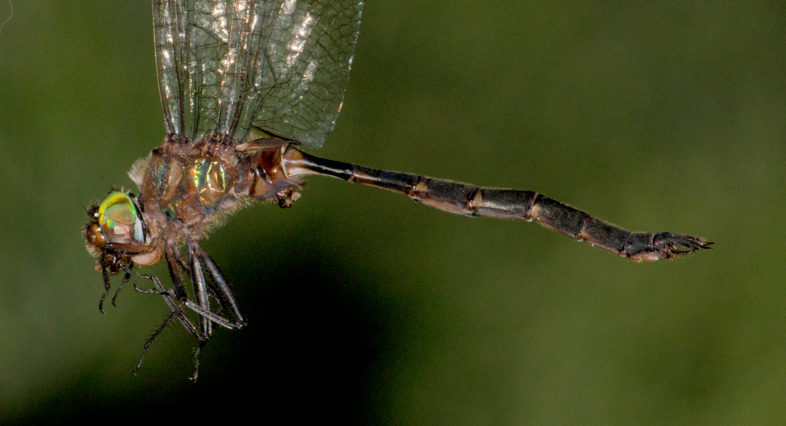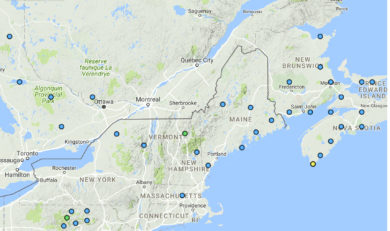
The first Incurvate Emerald found in Vermont. Click on the image to see the report on iNaturalist Vermont. / © Josh Lincoln
By Michael Blust with Joshua Lincoln
The iridescent green of their eyes is captivating. There are 11 species of striped emerald dragonflies in the Northeast, but the rarest one, the Incurvate Emerald (Somatochlora incurvata), had never been found in Vermont. Several of us had searched for it, but because it’s rare, its habits aren’t well known. It haunts bogs; we knew that much. But what kind of bog in Vermont? And when are they flying here?
Bryan Pfeiffer hatched a plan to go to Victory Bog – not a trail near it, or a road around it, and hike into its core. As fate would have it, health problems got in his way. Meanwhile I put out a summons for an end of the season attempt to find the missing emerald. Deciding to go forward with Bryan’s plan, but without Bryan’s familiarity of the area, Josh Lincoln and I checked out a southern route that would put us on a road from which we could then bushwhack into the bog. Unfortunately, the road was gated.
The alternative route was from the north and depended on the Moose River being relatively low, and thankfully, it was. So down the banks into the river we went. Zebra Clubtails greeted us in good numbers – two weeks later than their previously recorded late date in Vermont. Some places in the river were a bit deep and necessitated finding a way up the banks, through the surrounding brush, and back down at another spot. It will get easier when we get to a small stream that we can follow to the bog, right? Not exactly.
That small stream was not the bubbly gravel path we envisioned. It was dammed into a mucky, slippery, obstacle course by beaver. The size of their holes in the banks had us wondering about aquatic bears. Walking through the brushy and hummocky landscape above the stream was no easy ordeal either. Frequent missteps into pitfall traps left us straining to extract ourselves from the muck that did not want to let go. Eventually we decided to fight our way through thick brush to get to the trees. Walking was a bit easier here, though there were still lots of obstacles and soft spots.
After two hours, we finally broke out into the bog itself. Having never been there, we did not know what kind of bog to expect. No open pools of water were visible. We weren’t even sure if this was good habitat for our quarry or not. We didn’t have much time given the two hour return hike and long drive home. Josh went to check out a somewhat wetter area of the bog while I, tired from our two-hour obstacle course, decided to try the “sit and observe” strategy. After a quick 45 minutes on the bog, we each had a male of what we thought were Forcipate Emeralds. A close look-alike to Incurvate Emerald. We thought we would be able to tell them apart in the field, but we were not as well versed in what to look for as we should have been. We decided to take the specimens back and check them under the microscope and with reference books. It was then that we fully realized our success. Incurvate Emerald was now the 145th species of odonate for the Vermont Damselfly and Dragonfly Atlas. Elated but exhausted, we declared victory from Victory.
You Can Help find and monitor dragonflies Too!
Every dragonfly and damselfly counts — from the common to the rare. Even if you lack experience with these insects, you can contribute to the Vermont Damselfly and Dragonfly Atlas. Report your sightings to either iNaturalist Vermont or Odonata Central. Learn more at the Vermont Damselfly and Dragonfly Atlas at the Vermont Atlas of Life.


How exciting, what a safari!
Congratulations, guys. Bryan is cheering even though he was not there.
Can you share the distinguishing features from the forcipate?
Congratulations on the great find, Mike and Josh! What an expedition and so glad to hear it yielded the prize.